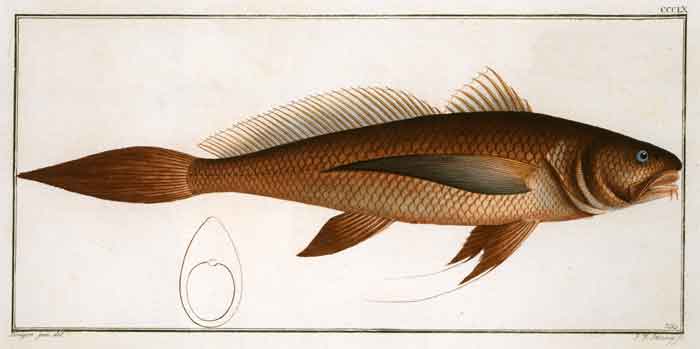Superregnum: Eukaryota
Cladus: Unikonta
Cladus: Opisthokonta
Cladus: Holozoa
Regnum: Animalia
Subregnum: Eumetazoa
Cladus: Bilateria
Cladus: Nephrozoa
Superphylum: Deuterostomia
Phylum: Chordata
Subphylum: Vertebrata
Infraphylum: Gnathostomata
Megaclassis: Osteichthyes
Superclassis/Classis: Actinopterygii
Classis/Subclassis: Actinopteri
Subclassis/Infraclassis: Neopterygii
Infraclassis: Teleostei
Megacohors: Osteoglossocephalai
Supercohors: Clupeocephala
Cohors: Euteleosteomorpha
Subcohors: Neoteleostei
Infracohors: Eurypterygia
Sectio: Ctenosquamata
Subsectio: Acanthomorphata
Divisio/Superordo: Acanthopterygii
Subdivisio: Percomorphaceae
Series: Eupercaria
Ordo: Perciformes
Subordo: Percoidei
Superfamilia: Percoidea
Familia: Sciaenidae
Genus: Lonchurus
Species: L. elegans – L. lanceolatus
Name
Lonchurus Bloch, 1793
References
Santos, S., Gomes, M. d. F., Soares Ferreira, A. R., Sampaio, I. & Schneider, H.; 2012: Molecular phylogeny of the western South Atlantic Sciaenidae based on mitochondrial and nuclear data. Molecular Phylogenetics and Evolution, Available online 4 October 2012, In Press, Accepted Manuscript, abstract
Lonchurus – Taxon details on Integrated Taxonomic Information System (ITIS).
Lonchurus species list in FishBase,
Froese, R. & Pauly, D. (eds.) 2024. FishBase. World Wide Web electronic publication, www.fishbase.org, version 02/2024.
Vernacular names

Lonchurus lanceolatus
Lonchurus is a genus of marine ray-finned fishes belonging to the family Sciaenidae, the drums and croakers. These fishes are found in the Western Atlantic.
Taxonomy
Lonchurus was first proposed as a genus in 1793 by the German physician and naturalist Marcus Elieser Bloch when he described Lonchurus barbatus from Suriname.[1][2] Subsequently L. barbatus was found to be a synonym of Bloch's 1788 species, Perca lanceolatus.[2] This genus has been placed in the subfamily Micropogoninae by some workers,[3] but the 5th edition of Fishes of the World does not recognise subfamilies within the Sciaenidae which it places in the order Acanthuriformes.[4]
Etymology
Lonchurus means "spear tail" and refers to the pointed, lance like tail of L. lanceolatus.[5]
Species
Lonchurus contains the following species:[6]
Lonchurus elegans (Boeseman, 1948) (Blackfin croaker)
Lonchurus lanceolatus (Bloch, 1788) (Longtail croaker)
Some authorities classify the blackfin croaker (L. elegans) in the genus Paralonchurus and treat Lonchurus as a monospecific genus.[2]
Characteristics
Lonchurus croakers have a elongate, slightly compressed body with a long head. They have small eyes and a cone-shape snout which protrudes past the horizontal mouth. There are between 1 and 15 pairs of mental barbels, as well as 4 or 5 pores, on the chin. The margin of the preoperculum is not serrated and there is a notch on the upper angle of the operculum. The dorsal fin is supported by 10 or 11 spines and between 31 and 39 rays. They have a very long, pointed pectoral fin and the caudal fin is pointed too. The anal fin is supported by a pair of weak spins and between 6 and 9 soft rays.[7] These fishes reach a maximum published total length of 32 cm (13 in).[6]
Distribution and habitat
Lonchurus croakers are found in the Western Atlantic Ocean off the western coast of South America and in the Windward Islands. They are coastal and estuarine fishes found over sand, mud and mixed sand and mud bottoms.[8][9]
Utilisation and conservation status
Lonchurus croakers are caught as food fish. They are mainly taken as bycatch. The IUCN have too little information on the population, ecology, distribution and threats of L. elegans and classify it as Data Deficient.[10] They classify L. lanceloatus as being of Least Concern.[11]
References
Wikimedia Commons has media related to Lonchurus.
Wikispecies has information related to Lonchurus.
Eschmeyer, William N.; Fricke, Ron & van der Laan, Richard (eds.). "Genera in the family Sciaenidae". Catalog of Fishes. California Academy of Sciences. Retrieved 22 May 2023.
Eschmeyer, William N.; Fricke, Ron & van der Laan, Richard (eds.). "Species in the genus Lonchurus". Catalog of Fishes. California Academy of Sciences. Retrieved 22 May 2023.
Kunio Sasaki (1989). "Phylogeny of the family Sciaenidae, with notes on its Zoogeography (Teleostei, Peciformes)" (PDF). Memoirs of the Faculty of Fishes Hokkaido University. 36 (1–2): 1–137.
J. S. Nelson; T. C. Grande; M. V. H. Wilson (2016). Fishes of the World (5th ed.). Wiley. pp. 497–502. ISBN 978-1-118-34233-6.
Christopher Scharpf & Kenneth J. Lazara, eds. (9 March 2023). "Series Eupercaria (Incertae sedis): Families Callanthidae, Centrogenyidae, Dinopercidae, Emmelichthyidae, Malacanthidae, Monodactylidae, Moronidae, Parascorpididae, Sciaenidae and Sillagidae". The ETYFish Project Fish Name Etymology Database. Christopher Scharpf and Kenneth J. Lazara. Retrieved 22 May 2023.
Froese, Rainer; Pauly, Daniel (eds.). "Species in genus Lonchurus". FishBase. February 2023 version.
"Genus: Lonchurus, Longtail Croaker, Croakers". Shorefishes of the Greater Caribbean online information system. Smithsonian Tropical Research Institute. Retrieved 22 May 2023.
Froese, Rainer; Pauly, Daniel (eds.). "Lonchurus elegans". FishBase. February 2023 version.
Froese, Rainer; Pauly, Daniel (eds.). "Lonchurus lanceolatus". FishBase. February 2023 version.
Aguilera Socorro, O. (2020). "Lonchurus elegans". IUCN Red List of Threatened Species. 2020: e.T47147840A82680106. doi:10.2305/IUCN.UK.2020-2.RLTS.T47147840A82680106.en. Retrieved 22 May 2023.
Aguilera Socorro, O.; Chao, L. & Santos, S. (2020). "Lonchurus lanceolatus". IUCN Red List of Threatened Species. 2020: e.T47147979A82680261. doi:10.2305/IUCN.UK.2020-2.RLTS.T47147979A82680261.en. Retrieved 22 May 2023.
Retrieved from "http://en.wikipedia.org/"
All text is available under the terms of the GNU Free Documentation License

